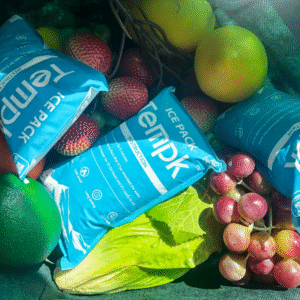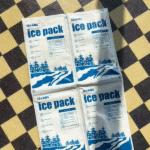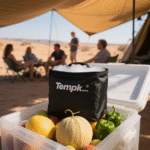So verpacken Sie Lebensmittel mit Trockeneis sicher 2025
Wenn Sie suchen wie man Lebensmittel mit Trockeneis verpackt, Dieser Leitfaden gibt Ihnen einen genauen Überblick, konformer Prozess – Ausrüstung, Schritte, und wie viel Sie für 24–72 Stunden verwenden sollten. Sie erfahren auch die aktuellen Beschränkungen für Fluggesellschaften und Kurierdienste, sichere Lebensmitteltemperaturen, und einen Größenplaner zum Kopieren und Verwenden, damit Ihre Box kalt und konform ankommt.
-
Größenregeln: eine einfache Möglichkeit, Trockeneis zu schätzen 24/48/72 Stunden Haltezeit.
-
Regulatorische Grundlagen: was auf das Kästchen geschrieben werden soll (UN1845, Klasse 9, Netto-Kilogramm) und Flugpassagierlimits.
-
Schrittweises Auspacken: ein wiederholbarer Arbeitsablauf, den Sie in wenigen Minuten trainieren können.
-
Risikokontrollen: Entlüftung, PS, und sichere Annahme von Schecks, um Ansprüche zu reduzieren.
Welche Ausrüstung benötigen Sie, um Lebensmittel mit Trockeneis zu verpacken??
Kurze Antwort: Verwenden Sie einen entlüfteten Hartkühler oder einen EPS/VIP-Versandbehälter, 1–2″ Isolierung, Lebensmittelechte Beutel, Saugfähige Einlage, Dampfbarriere, Isolierte Handschuhe, and Class 9/UN1845 labels showing net kg Trockeneis. Never seal the inner package airtight—CO₂ must vent.
Warum funktioniert es: Thick insulation slows heat gain. Sealed food bags block odor and moisture. Absorbent pads protect cartons. Gloves prevent frostbite at −78.5 °C. Venting prevents pressure buildup and reduces CO₂ exposure in vehicles or rooms, improving safety and compliance during checks.
Block vs. pellet dry ice for longer hold?
Einzelheiten: Blocks sublimate slower than pellets because of smaller surface area; pellets cool faster but vanish sooner. For quick pull‑down plus endurance, lay blocks on the base and pellets on top. This hybrid cut keeps the payload cold and evens temperature across the load.
| Pack‑Out Choice | Typische Verwendung | Auswirkung auf die Haltezeit | Was es für Sie bedeutet |
|---|---|---|---|
| Blocks on base | Lange Gassen, fewer openings | Langsamere Sublimation | Less weight loss over time |
| Pellets on top | Schnelles Herunterziehen | Schnellere Sublimation | Quicker chill, Fügen Sie einen Puffer hinzu |
| Hybrid stack | Mixed needs | Balanced profile | Better stability across 24–72 h |
Practical tips and common mistakes
-
Nicht luftdicht verschließen: leave a vent path for CO₂.
-
Pad and line: add a poly liner and corrugated pad to avoid brittle cracking and wet cartons.
-
Label smart: write UN1845 + netto kg on a vertical panel; Halten Sie die Etiketten frei.
Real -World -Fall: A catering team moved 8 kg meals in a 2″ shipper with 14 lb dry ice for a 44‑hour lane; chilled items arrived 28–34 °F and desserts stayed frozen—no condensation leaks.
How much dry ice do you need to pack food with dry ice?
Faustregel: Planen ~5–10 lb per 24 hours in a typical insulated shipper. Increase for hot vans or frequent openings; decrease with premium insulation or larger blocks. Start frozen at 0 °F or chilled ≤40 °F.
Why the range changes: Hitze, altitude/low pressure, Pelletgröße, and container wear all increase sublimation. Worn or thin EPS walls need more dry ice; 2″ EPS or VIP needs less for the same lane.
Quick planner you can copy and use
Use it like this: Multiply hours by the base rate, then adjust for insulation and access. If food weight is high, apply the 0.5 lb/lb floor. Test on your lane and log receiving temperatures to validate.
| Containertyp | Typische Mauer | Ost . Trockeneis / Tag | Was es für Sie bedeutet |
|---|---|---|---|
| Thin EPS shipper | ~1″ | 8–12lb | Budget option; add ice or choose faster service |
| Standardkühler | ~ 1,5 " | 6–10 Pfund | Good balance for road trips and 2‑day lanes |
| Premium EPS/VIP | ≥2″ | 4–8 Pfund | Lower weight for 48–72 h lanes |
Umsetzbare Szenarien
-
48 H im Sommer: choose the upper range, 20–30 % Puffer hinzufügen, und Deckelöffnungen reduzieren.
-
Mixed chilled + gefroren: getrennte Zonen; gels near chilled items, dry ice near frozen.
-
Frequent access cooler: plan toward 10 lb/24 h and use a top layer to cut warm‑air ingress.
How to pack food with dry ice step‑by‑step?
Kernschritte (why it works in bold):
-
Pre‑chill to ≤40 °F or freeze to 0 °F. Starting cold preserves hold time.
-
Double‑bag and add a vapor barrier. Moisture and odor stay contained.
-
Line with absorbent pads. Protects the carton.
-
Fügen Sie a hinzu Block layer of dry ice.
-
Load food in the center.
-
Fügen Sie a hinzu Spitze dry ice layer. Cold CO₂ sinks through the payload.
-
Fill voids to reduce convection.
-
Schließen Sie mit a Entlüftungsweg.
-
Markieren Sie UN1845, Klasse 9, Und Netto-Kilogramm Trockeneis.
Receiving SOP: open in ventilation, confirm UN1845/Class 9 Markierungen, probe the thickest item, accept if chilled ≤40 °F or still frozen/with ice crystals, then stage to cold storage and log results.
Can you fly with dry ice when you pack food with dry ice?
Ja. Passagiere können tragen bis zu 2,5 kg (5.5 lb) pro Person In ventable packages with airline approval; checked bags must be marked “Dry ice/Carbon dioxide, solid” with the Nettogewicht or “2.5 kg or less.” Follow the airline’s page and declare at check‑in.
Airport checklist: rigid leak‑resistant outer, foam inner, lid not airtight, exterior marks (UN1845 + Netz kg), and an accurate scale reading if asked. For carry‑on size limits, use smaller blocks and 2–3 lb dry ice.
How to ship with UPS/USPS/FedEx when you pack food with dry ice?
Marking basics (Luftfracht): proper name “Dry ice/Carbon dioxide, solide,”UN1845, Klasse 9 Etikett, and visible Netto-Kilogramm of dry ice on a vertical side; keep the package ventable. USPS air mailpieces are capped at 5 lb Trockeneis pro Stück; surface may allow more.
Hand‑off tips that prevent delays: schreiben kg (you can add lb in parentheses), Halten Sie die Etiketten frei, don’t write across hazard diamonds, and choose the shortest lane you can afford—fewer hours means less dry ice.
2025 Entwicklungen und Trends in der Kühlkette
Was ist neu: 2025 passenger and cargo guidance reaffirmed UN1845 acceptance points, sichtbar Netz - kg Markierungen, and ventable packaging. USPS Publication updates confirm the 5 lb air limit mit Entlüftung, while surface services may exceed 5 lb. Testing continues to show pellet size and container wear as major drivers of loss—another reason to upgrade insulation and retire damaged boxes.
Neueste Fortschritte auf einen Blick
-
Akzeptanzdisziplin: counters rely more on checklists; net‑kg marks reduce stoppages.
-
Planner mainstream: Die 5–10 lb/Tag band is now common in carrier/EHS guidance—plan, Dann validieren Sie auf Ihrer Spur.
-
Hybrid-Packouts: Gele + dry ice stabilize mixed payloads and buffer openings, especially on two‑day lanes.
Market insight: DTC desserts and meal kits are shifting weight from “more dry ice” to “better insulation” and simple temperature logging to cut claims and freight.
Häufig gestellte Fragen
Wie viel Trockeneis für 48 hours of frozen hold?
Beginnen Sie mit 10–16 Pfund in standard shippers or 8–12lb with ≥2″ EPS/VIP. Add 20–30% in heat or if you’ll open the lid.
Is airtight better to “trap the cold”?
NEIN. Dry‑ice packages muss CO₂ Wind. Airtight seals risk rupture and non‑compliance.
What temperature proves my food stayed safe?
Gekühlt: ≤40 °F (4 ° C). Gefroren: 0 ° F (–18 ° C.) or ice crystals present at receiving. Use a probe thermometer.
Wo soll ich das Trockeneis platzieren – oben oder unten??
For freezer mode, place some oben so cold CO₂ sinks; for chilled‑only, keep it below with a buffer so items don’t freeze.
Ist Trockeneis im Auto sicher??
Lüften. Co₂ verdrängt Sauerstoff. Keep windows cracked and vents open; never sleep in a vehicle with dry ice inside.
Two‑minute self‑assessment (interaktiv)
-
Transitzeit: <24 H / 24–48H / 48–72H / >72 H
-
Ambient: Cool / leicht / heiß
-
Absender: EPS 1″ / Eps 2 " / VIP
-
Ziel: arrive gefroren / arrive gekühlt
Ergebnis: Für wie man Lebensmittel mit Trockeneis verpackt, wählen 5–10 Pfund pro 24h, multiply by days, then add +20–30% if hot or frequently opened. Upgrade insulation if >72 h or weight is a concern.
Zusammenfassung und Empfehlungen
Schlüsselpunkte: Pick a ventable insulated shipper, Trockeneis darüber und darunter schichten, Hohlräume füllen, und Mark UN1845/Class 9 mit Netto-Kilogramm. Planen ~5–10 lb/day, add a buffer for heat or openings, and verify arrival temps (≤ 40 ° F gekühlt, 0 °F frozen or ice crystals). Validate with a small test on your lane.
Nächste Schritte (Dein Plan):
-
Choose the container (target ≥2″ walls for 48–72 h).
-
Use the sizing planner and add a 20–30% buffer for summer.
-
Print the step list and receiving SOP; train your team.
-
Für Flüge, weigh and write Netz kg, then pre‑clear with your airline.
Über Tempk
Wir sind ein Team für Kühlkettenlösungen, das sich auf die Praxis konzentriert, test‑backed packaging for 24–72‑hour lanes. Our seafood, meal kit, and dessert shippers are validated with vent paths, Feuchtigkeitskontrolle, and easy‑apply labels—paired with SOPs, Taschenrechner, and training to cut claims and dry‑ice waste. Get a tailored pack‑out and label set for your route.
CTA: Get a free dry‑ice sizing plan for your specific lane.
























